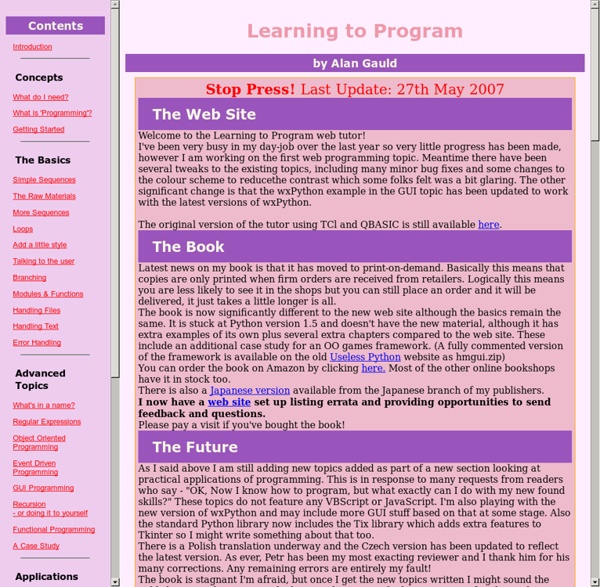



Blender 3D: Blending Into Python - Wikibooks, collection of open-content textbooks This is the start of a Blender/Python manual. At the moment the most useful areas are the optimization guide and the cookbook. Python is high-level, easy to learn scripting language, that can be applied to various aspects of Blender, and MANY other things. Contents[edit] Please feel free to add content to other areas. Optimize — Python/Blender Optimization GuideCookbook — Blender/Python CookbookBlender 3D:OrphanScripts — Orphan Scripts - community maintained scripts.Features — Python/FeaturesBlender Python C API2.5 quickstartReference Further reading[edit] Python Programming Language External links[edit] Blender Python 2.46 API Reference — Python API Reference.
Text Processing in Python (a book) A couple of you make donations each month (out of about a thousand of you reading the text each week). Tragedy of the commons and all that... but if some more of you would donate a few bucks, that would be great support of the author. In a community spirit (and with permission of my publisher), I am making my book available to the Python community. Minor corrections can be made to later printings, and at the least errata noted on this website. Email me at <mertz@gnosis.cx> . A few caveats: (1) This stuff is copyrighted by AW (except the code samples which are released to the public domain).
Python Ecosystem - An Introduction » mirnazim.org When developers shift from PHP, Ruby or any other platform to Python, the very first road block they face (most often) is a lack of an overall understanding of the Python ecosystem. Developers often yearn for a tutorial or resource that explains how to accomplish most tasks in a more or less standard way. What follows is an extract from the internal wiki at my workplace, which documents the basics of the Python ecosystem for web application development for our interns, trainees and experienced developers who shift to Python from other platforms. This is not a complete resource. Intended Audience This is not about teaching Python - the programming language. I am assuming you are working on Linux (preferably Ubuntu/Debian) or a Linux-like operating system. Search the web for the best possible ways of installing Python on your operating system. The version confusion TL;DR: Python 2.x is the status quo; Python 3 is the shiny new thing. Which VM to use Installing Python sudo yum install python2.7
BeginnersGuide - PythonInfo Wiki New to programming? Python is free and easy to learn if you know where to start! This guide will help you to get started quickly. Chinese Translation/中文版入门 New to Python? Read BeginnersGuide/Overview for a short explanation of what Python is. Getting Python Next, install the Python 3 interpreter on your computer. There are also Python interpreter and IDE bundles available, such as Thonny. At some stage, you'll want to edit and save your program code. Learning Python Next, read a tutorial and try some simple experiments with your new Python interpreter. If you have never programmed before, see BeginnersGuide/NonProgrammers for a list of suitable tutorials. Most tutorials assume that you know how to run a program on your computer. Some sites offer in-browser coding for those who want to learn Python: Print a cheat sheet of the most important Python features and post it to your office wall until you know the basics well. Need Help? Need help with any of this? Complete list of Beginner's Guide pages
Python TechCrunch - The latest technology news and information on startups s Python Class - Educational Materials Welcome to Google's Python Class -- this is a free class for people with a little bit of programming experience who want to learn Python. The class includes written materials, lecture videos, and lots of code exercises to practice Python coding. These materials are used within Google to introduce Python to people who have just a little programming experience. To get started, the Python sections are linked at the left -- Python Set Up to get Python installed on your machine, Python Introduction for an introduction to the language, and then Python Strings starts the coding material, leading to the first exercise. This material was created by Nick Parlante working in the engEDU group at Google. Tip: Check out the Python Google Code University Forum to ask and answer questions.
Python re Module - Use Regular Expressions with Python - Regex Support Python is a high level open source scripting language. Python's built-in "re" module provides excellent support for regular expressions, with a modern and complete regex flavor. The only significant features missing from Python's regex syntax are atomic grouping, possessive quantifiers, and Unicode properties. The first thing to do is to import the regexp module into your script with import re. Regex Search and Match Call re.search(regex, subject) to apply a regex pattern to a subject string. You can set regex matching modes by specifying a special constant as a third parameter to re.search(). re.I or re.IGNORECASE applies the pattern case insensitively. re.S or re.DOTALL makes the dot match newlines. re.M or re.MULTILINE makes the caret and dollar match after and before line breaks in the subject string. By default, Python's regex engine only considers the letters A through Z, the digits 0 through 9, and the underscore as "word characters". Do not confuse re.search() with re.match().